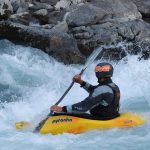Transporting a kayak with a J rack is really easy and convenient. If you have never loaded a kayak on a J rack before, you may need step-by-step instructions to help you lift and attach the kayak securely.
Moving kayaks can be an obstacle for many kayak proprietors. You have the option of employing a truck, trailer, or SUV to bring your kayak to your preferred area.
Transportation is easy if you have an inflatable kayak. If you possess a kayak with a hardshell, carrying it with a J rack would be the wisest choice.
In this article, we are going to go over all the essential information for getting a kayak loaded onto a J rack. I am hoping that this location will provide you with some helpful advice and techniques.
J Rack Installation
Compact automobiles, Sports Utility Vehicles, and pick-up trucks are the ideal kinds of automobiles for equipping with a J Rack. If the roof of the car is too tall, it will be very difficult to get the shelf up to that level.
Your car should already have a kind of tray to which the J rack can be fastened. The J rack is not symmetrical; one side is shorter than the other.
In general, you should position the lengthier side of the rack outward. In this situation, you have to put the kayak onto your vehicle from the rear.
Consider putting the shorter end away from the center if you don’t want to do the original thing. This will make it possible for you to place your kayak on the side of your vehicle. It will be simpler for you to complete the task due to the fact that you can utilize the running board of your car if you require additional elevation.
If you are worried about safety, opt for a J rack that includes a lock. Although it may cost more, there will be no concerns regarding the safety of the rack.
In most cases, no extra hardware is required to install a J Rack. You must make sure to securely fasten the screws that come with the rack.
How To Load a Kayak on J Rack
The manner in which a kayak is placed on a J rack relies partly on the kind of car and the sort of rack. It is advisable to enlist the help of someone to assist in lifting and getting your kayak ready for transportation if it is too heavy for you to handle on your own.
Generally, you’ll follow three steps to get a kayak on your vehicle: first, set the kayak down on the floor; then, hoist it either from the side or back of the vehicle; finally, attaching the kayak to the J rack.
Step 1: Situate Your Kayak in an Advantageous Position on The Ground
If it would be beneficial, put the kayak with its front side facing up. Invert your kayak, with the bottom facing towards the ground, if you want to secure it to a crossbar.
Step 2: Lifting The Kayak
You can take the kayak off of the side or back of your car. Let’s see what the procedure should look like.
Loading from the Side
It is more straightforward to load a kayak onto a car if two people are working together. As you raise the container, you will need to turn it towards yourself. If the kayak is substantial in size, it will be challenging to control the boat.
Position yourself at either the back or the front of the kayak. Pick up the gunwale and place it onto the J rack. Once you have succeeded in raising the kayak to the level of the J rack, it’s simple to place the kayak against the edge of the rack. Then you can just push the boat into place.
Loading from the Rear
If you’re the only one lifting the kayak, it will probably be simpler to get it on the back of your car than trying to slide it on the side. This method is ideal for raising a bulky or prolonged kayak.
The front of the kayak should be in line with the back of the car when the kayak is on the ground. Think about putting a cushion underneath the backside of the boat to guard it from getting hurt.
Once you have successfully raised the bow of the kayak to the required height, you will need to move it forward. It would be beneficial to set the mat a distance of two or three feet away from the back of the boat. Ensure that the front of the kayak is proper fit into the rack’s slot.
By positioning the cushion slightly ahead of the back end of the kayak, you will also stop it from slipping away from you when you push it onward.
Once the bow is secured in the J rack’s channel, head towards the back of the boat. Rotate the kayak while lifting the back end carefully makes sure the gunwale is fastened in the groove.
Step 3: Secure Kayak Down
You can tie down your kayak to the rack with cam straps. Just be sure to tighten the straps carefully. Beware not to fasten the straps on your kayak too hard, or you may end up damaging it.
Place both the straps on top of your boat. The amount of effort required may vary based on the size of the boat and the height of the person.
The straps must be arranged in a manner that the cam clips on both ends corresponds with the two sides of the crossbar. Put the buckle in a place where it is easy to access and use the strap to make it tight. Take the other end of the band and place it across the rails and secure it to the clasp.
After the belt has been threaded through the buckle, tug it firmly. Repeat the same steps to secure the back part of the kayak.
Loading the Kayak on the Car Roof Top
I had previously viewed some videos on YouTube to learn the correct technique for attaching the straps, which made it simpler to begin with the two straps already threaded through the hooks. Then I had my teenage son aid me in getting my 10 foot kayak placed in the holders, making sure to place it right in the middle.
I was aware that the open part of the kayak should be pointed out of the car, and the back should be angled against the longer side of the J Hook.
I reasoned that it would be better to position the kayak with the bow of it facing towards the front of my car so the the wind created from driving forward wouldn’t be hit directly by the bottom of the bow.
I assumed that on this particular kayak, the seat would act as a barrier, which would lead to the wind passing over the seat instead of entering the stern.
Putting a kayak in place on your roof rack with a cradle is easy – you just drape the straps over the top, then secure them all in one area. In the past, I would place the kayak horizontally on the top of the car and go to both ends of the vehicle repeatedly with a stepladder to make sure the alignment was correct.
I figured out a way to secure ratchets or cam buckles to avoid getting the car door scratched – keep one side of the strap short and the other side long. This way when you throw the short end over the car, the door won’t be damaged.
Remember to hold onto the end of the rope firmly when you are using the cam or ratchet lever, as its weight can mean it goes further than anticipated and cause damage.
Securing the Straps
Securing the kayak adequately is the biggest step of the whole process. Failure to do so can lead to disaster. These are some useful pointers, some more crucial than the rest.
You can use either cam buckle or ratchet tie-downs to hold the kayak in place. The cords will go over the kayak, starting at the longer J-Hooks at the back, and go straight to the shorter hooks at the front. The cables should be wound around the rack itself, not just the J hook.
Be aware that it may be very irritating to pass the strap through a ratchet if it is your first time doing it. It took me a number of attempts before I had gotten the buckle to go through the middle wheel correctly and at the correct size.
Determining how to loosen the strap if it is too tight? It could be said that acquiring knowledge and skill about the subject in question requires effort, as well as being able to use one’s fingers accurately.
“The straps may damage the paint. A strap damaged my truck tail gate by rubbing. Randy M. suggests having something soft, such as a cloth, underneath the straps, potentially taped onto them.
If you collapse the ratchet into a V-formation, the handle should move from the top downward when you are tightening it, with the handle facing toward you.
If the strap becomes too tightened as you try to ratchet it onto the spool, start the process again but make sure to pull through more of the strap’s loose end before you start ratcheting again.
You will not need to cut the strap to make things work this way.
You should not only loop the straps through the hooks, but you should also thread them under the car rack. This will provide extra security.
I appreciate that the tie downs are attached to the car and not just the roof rack, as well as having ones both in the front and back. Barry G. of New Jersey believes that many individuals are not succeeding in that particular aspect.
Place the buckle or ratchet on a level section of the kayak, such as the deck, for stronger protection from gusts of wind, as well as easier cinching.
Fasten the loose ends of the straps tightly to reduce flapping or the humming sound that happens when the wind blows. Nothing is more nerve-wracking than the sound of something when driving swiftly down the roadway.
Ensure that the two primary straps are firmly fastened. Check the stability of the kayak by giving it a strong shake.
About Bow and Stern Straps
There are mistaken beliefs regarding the usage of bow and stern lines. You may be astonished to find out that bow and stern lines are not used to secure your kayak tightly to your car.
The purpose of the straps is to stop the kayak from going forward or backward if you have to suddenly hit the brakes, or worse, prevent it from cruising through the back window of the car in front.
For this purpose, these two extra straps should be fastened firmly, yet not to the point of being too tight. In some cases, not doing so can result in damage to your kayak.
Take a Road Test
I had just used the prior weekend to transport a Queen-sized mattress on the roof of the other vehicle we own. I really wanted to be certain that the new J Bars and kayak were completely safe after enduring a stressful four-hour trip. I
f I could hear any buzzing coming from the straps or detect any sound from up on the roof, I would be filled with unease the whole time I was travelling.
I then tested out the bow and stern lines, which I had acquired individually, by taking it for a spin on a nearby road. I began driving on the city roads at a velocity of 35 miles per hour, and then gradually built up my speed to 60 mph as I transitioned to the highway.
During the experiment, I was made aware that the loose parts required more secure attachment because even though they weren’t vibrating, it was still unsettling to have them waving around.
After having completed a 20-minute trip on the highway as well as some quick turns, I was generally pleased. The other thing I did was check the forecast. It had been reported that J Bar Racks were highly dependable, yet it was still smart to be careful when utilizing them in gusty conditions.
The entirety of my journey was via Highway 101 in California, so I was aware that certain areas could be gusty. I was thankful that the forecast didn’t predict strong winds.




